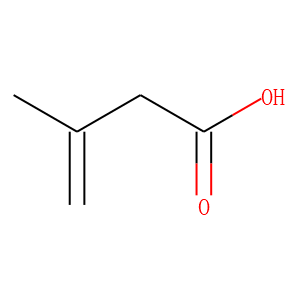| Reference | [1]. Clin Chim Acta. 1980 Sep 8;106(1):85-9. doi: 10.1016/0009-8981(80)90377-0.<br />
3-methyl-3-butenoic acid: an artefact in the urinary metabolic pattern of patients with 3-hydroxy-3-methylglutaryl-CoA lyase deficiency.<br />
Jakobs C, Bojasch M, Duran M, Ketting D, Wadman SK, Leupold D.<br />
DOI: 10.1016/0009-8981(80)90377-0 PMID: 6157502 [Indexed for MEDLINE]<br />
<br />
[2]. Plant Biol (Stuttg). 2018 May;20(3):563-578. doi: 10.1111/plb.12687. Epub 2018 Feb 8.<br />
Diversity of pollination ecology in the Schismatoglottis Calyptrata Complex Clade (Araceae).<br />
Hoe YC(1)(2), Gibernau M(3), Wong SY(2)(4).<br />
Author information: (1)Tunku Abdul Rahman University College, Johor Branch Campus, Johor, Malaysia. (2)Faculty of Resource Science and Technology, Universiti Malaysia Sarawak, Sarawak, Malaysia. (3)Natural Resources Project, Vignola Route des Sanguinaires Ajaccio, CNRS – University of Corsica, Ajaccio, France. (4)Harvard University Herbaria, Cambridge, MA, USA.<br />
Field studies integrating pollination investigations with an assessment of floral scent composition and thermogenesis in tropical aroids are rather few. Thus, this study aimed to investigate the pollination biology of nine species belonging to Schismatoglottis Calyptrata Complex Clade. The flowering mechanism, visiting insect activities, reproductive system, thermogenesis and floral scent composition were examined. Anthesis for all species started at dawn and lasted 25-29 h. Colocasiomyia (Diptera, Drosophilidae) are considered the main pollinators for all the investigated species. Cycreon (Coleoptera, Hydrophilidae) are considered secondary pollinators as they are only present in seven of the nine host plants, despite the fact that they are the most effective pollen carrier, carrying up to 15 times more pollen grains than Colocasiomyia flies. However, the number of Colocasiomyia individuals was six times higher than Cycreon beetles. Chaloenus (Chrysomelidae, Galeuricinae) appeared to be an inadvertent pollinator. Atheta (Coleoptera, Staphylinidae) is considered a floral visitor in most investigated species of the Calyptrata Complex Clade in Sarawak, but a possible pollinator in S. muluensis. Chironomidae midges and pteromalid wasps are considered visitors in S. calyptrata. Thermogenesis in a biphasic pattern was observed in inflorescences of S. adducta, S. calyptrata, S. giamensis, S. pseudoniahensis and S. roh. The first peak occurred during pistillate anthesis; the second peak during staminate anthesis. Inflorescences of all investigated species of Calyptrata Complex Clade emitted four types of ester compound, with methyl ester-3-methyl-3-butenoic acid as a single major VOC (volatile organic compound). The appendix, pistillate zone, staminate zone and spathe emitted all these compounds. A mixed fly-beetle pollination system is considered an ancestral trait in the Calyptrata Complex Clade, persisting in Sarawak taxa, whereas the marked reduction of interpistillar staminodes in taxa from Peninsular Malaysia and especially, Ambon, Indonesia, is probably linked to a shift in these taxa to a fly-pollinated system.<br />
DOI: 10.1111/plb.12687 PMID: 29316090 [Indexed for MEDLINE]
|

